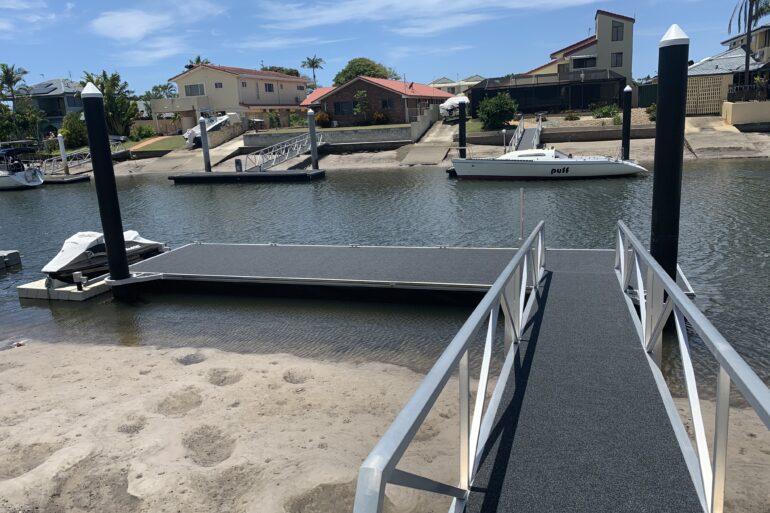
Pontoon docks are a specialised type of floating dock commonly used in residential settings as a jetty alternative. They comprise a series of connected components to form a stable platform.
While pontoon docks are most often used for mooring boats, jet skis and PWCs, they can also be used for various other activities, such as swimming, fishing, and sunbathing.
If you’re in the market for a new pontoon dock or curious to learn more about them, this post is for you! We’ll define and explain the most common pontoon dock terminologies so that by the time you finish reading, you’ll be an expert!
Barges: A barge is a flat-bottomed boat specially built for river and canal transport of heavy goods. We here at Micks Marine Maintenance have our own badge, which we use to transport and install marine piles on our pontoons.
Cleat: A cleat is a fitting on the pontoon dock to which lines can be fastened to moor a vessel.
Dry berth: This is a slip or space where a boat can be stored on land, out of the water. This is ideal for those who want to keep their vessel well-maintained or for those who live in areas where it freezes over in winter.
Fenders: Fenders are devices, usually made of foam or plastic, that are attached to the side of a boat or pontoon to protect it from damage when moored. Learn more about Pontoon Fenders.
Floating Dock: A floating dock is another term for a pontoon dock. Unlike fixed jetties, floating docks are anchored, allowing them to rise and fall with the tide.
Gangway: A gangway is a walkway that provides safe passage from land to a pontoon.
Mooring: Moorings are permanent anchors used to secure a vessel in place.
Mooring block: A mooring block is a shore-mounted concrete block that anchors a gangway and/or cables to support a floating dock.
Piling: Piling – or piles – is a term used to describe the support posts, usually made of wood, concrete, or steel, that are driven into the bottom of a body of water to create a foundation for a pontoon dock. Learn more about Piled Pontoons.
Pile Bracket: A pile bracket is a device that attaches a piling to a piled pontoon dock.
Pile Roller: A pile roller is a plastic cylindrical wheel housed within a pile bracket surrounding a pile. Its rolling mechanism allows a pontoon dock to move vertically up and down a pile with the tide.
Quay line: The Quay Line is a term used to describe ‘the line formed by the intersection between a waterway and adjoining land which determines the extent of a grant in respect of a jetty or wharf.’ In other words, the boundary between water and land. This line determines how far your pontoon dock can sit into a canal or river without getting too close to banks, bridges etc. Learn more about Quay Lines.
Seafloor: The seafloor is the bottom of a body of water, such as an ocean, lake, or canal, also known as the ocean floor, sea bottom, or sea bed. The term describes the ocean area covered by sediment, including the continental shelf, continental slope, and abyssal plain.
Strut arm: A strut arm is a horizontal beam that connects a pontoon dock to the shore and provides additional support. Learn more about Strut Pontoons.
Tidal Work Application: A Tidal Work application is a formal request for the proposed development or demolition of structures such as jetties, pontoons, seawalls, wharves, and embankments with the governing body. A Tidal Work Application must be approved before a pontoon dock can legally be installed. Learn more about Tidal Work Applications.
Conclusion
If you’re in the market for a pontoon dock, you must be familiar with all the terms used in the industry. In this comprehensive glossary, we’ve defined some of the most important terms related to pontoons docks. We hope this information will help you make an informed purchase and get your dream waterfront property!